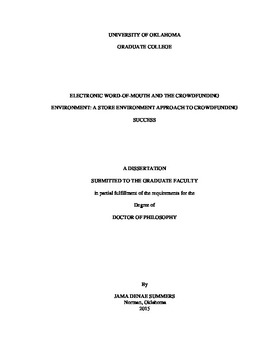| dc.description.abstract | Crowdfunding has transformed the new venture financing process by expanding the possibilities for not only who can receive funding but also who can become a funder in new venture projects. Rewards-based crowdfunding platforms such as Indiegogo.com offer individuals a “reward” in return for their contribution. The rewards-based crowdfunding environment is imbued with aspects of both new venture funding and internet-based consumer purchasing. A funder may hope to obtain a valued commodity in return for their contribution to a crowdfunding project. Yet, the uncertainty associated with the outcomes requires the funder to infer quality by considering the viability of the project plan and the abilities of the project team. Building upon the complementary perspectives of a rewards-based crowdfunding contribution as both an investment and a purchase, I use the store environment model from the consumer behavior literature as a lens for identifying the informational cues project teams use to convey the worth of their project to funders. Since crowdfunding relies on the interaction of the community, I draw from research on electronic word-of-mouth (eWoM) and social media to understand how social media “buzz” can act as a social cue within the crowdfunding environment, transforming the nature of the message conveyed by the project team. My findings indicate that crowdfunding environment does impact the total amount received for a project, alone and in tandem. More importantly, the type of cue matters; design cues (vividness and structuredness) work best when combined with other design cues and social cues (project team cues and social media “buzz”) work best with other social cues. First, vividness matters –particularly when combined with a well-structured text. Next, neither project team attributes not community discourse matter in isolation, but in combination they do. Finally, too much social media “buzz” has a negative effect on funding, particularly later in the campaign. My research presents the store environment model as a valuable lens for understanding crowdfunding outcomes. By illuminating the complementarities between the new venture financing and internet-based consumer purchasing perspectives of crowdfunding, I utilize a more comprehensive application of the store environment model than has been employed in online contexts previously and present social media eWoM (i.e. social media “buzz”) as a social cue having a significant impact in online store environments and the rewards-based crowdfunding environment in particular. I also highlight the importance of eWoM, in the form of social media “buzz,” as an indirect force on organizational outcomes, acting in tandem with other environment cues and differentially over time. | en_US |
